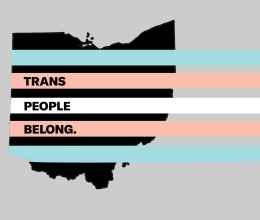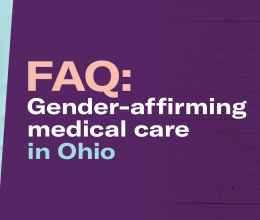Below is our Policy Strategist, Sean McCann's, opposition testimony on State Board of Education proposed resolution “to support parents, schools, and districts in rejecting harmful, coercive, and burdensome gender identity policies”. This written testimony was delivered to the State Board of Education for the September 20, 2022 meeting.
Board President McGuire, Vice President Manchester, and members of the State Board of Education: my name is Sean McCann, and I am a policy strategist for the American Civil Liberties Union (ACLU) of Ohio. Thank you for the opportunity to provide written comments on the proposed resolution before you today, which the Board should reject.
Not only does the proposed resolution contemplate a response to proposed federal regulations which have not yet taken effect (and for which the public comment period just recently closed), but the resolution also continues a pattern of demonizing an already marginalized population—LGBTQ+ youth and particularly transgender and gender nonconforming (TGNC) youth.
This dangerous resolution also contains a number of blatant medical falsehoods about transgender youth and the transition process. The clause listing a litany of supposed health consequences resulting from gender-affirming care, in particular, is demonstrably false and based on debunked studies. Gender-affirming care is a practice supported by major medical institutions like the American Academy of Pediatrics, the Endocrine Society, the American Academy of Child and Adolescent Psychiatry, and the American Psychiatric Association.
We know that LGBTQ youth (and especially TGNC youth) are at higher risk of attempting suicide than their peers, but those who found their schools and communities to be LGBTQ-affirming reported lower rates of attempting suicide, per the Trevor Project’s 2022 National Survey on LGBTQ Mental Health. Yet, this resolution furthers a culture of intimidating and harassing LGBTQ youth because of who they are, suggesting that simple steps like using a child’s preferred pronouns should be avoided. In reality, it is the simple steps that have the most impact; TGNC children who are addressed by their preferred pronouns are more than 50% less likely to commit suicide than their peers. Suicide is the second leading cause of death among young people, with LGBTQ+ youth being four times more likely to attempt.
By calling on the General Assembly to require schools to inform parents if their child questions their gender identity, the resolution ignores the reality that some parents may not be supportive of what their child is experiencing which increases their child’s risk of homelessness, substance abuse, and suicide. These situations should be approached with caution and care for the child, not a blanket policy that might result in greater emotional harm for the child.
The resolution also suggests that Title IX of the Education Amendments of 1972 does not protect against discrimination on the basis of sexual orientation or gender identity. However, the U.S. Department of Education (USDOE) in June 2021 issued a rule clarifying that, in fact, it does interpret “Title IX’s prohibition on sex discrimination to encompass discrimination based on sexual orientation and gender identity.” This clarifying rule followed the Supreme Court of the United States’ 2020 decision in Bostock v. Clayton County finding that Title VII of the Civil Rights Act of 1965 did include sexual orientation and gender identity in its ban on sex discrimination.
Further, the U.S. District Court for the Southern District of Ohio found in its 2020 Ray v. McCloud ruling that transgender people are entitled to heightened protection under the Equal Protection Clause as a quasi-suspect class. Thus, if the state proceeds with the resolution’s recommended policy of providing stopgap funding to schools who ignore Title IX, the state is essentially rewarding schools, via funding, for discriminating against a quasi-suspect class.
The bottom line is that this proposed resolution, should it take effect, would raise multiple legal issues for the state. It would also continue an incredibly dangerous pattern of targeting LGBTQ+ youth across Ohio and spreading misinformation about what it means to be TGNC, in particular. The Board should resoundingly reject the resolution and instead focus on ways to make our schools more welcoming spaces for LGBTQ+ youth.







